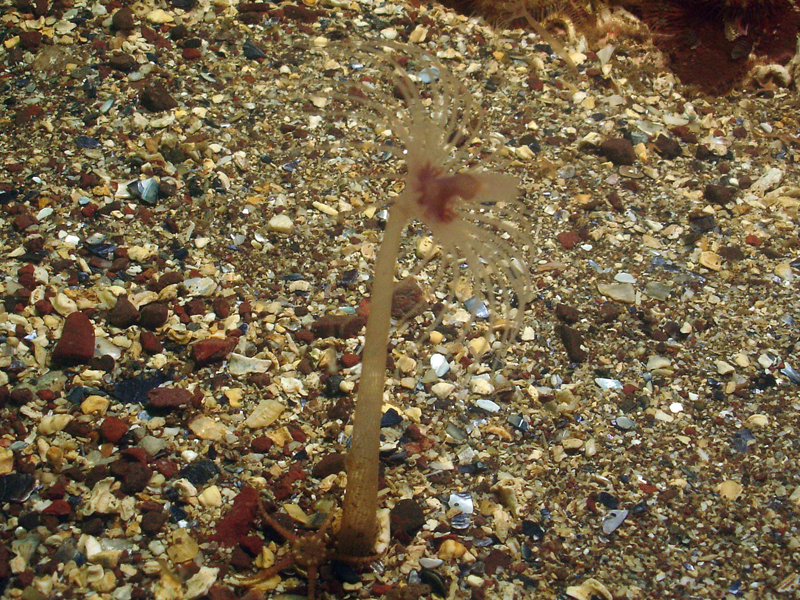Nodding sea fir (Corymorpha nutans)
Distribution data supplied by the Ocean Biodiversity Information System (OBIS). To interrogate UK data visit the NBN Atlas.Map Help
| Researched by | Saskiya Richards | Refereed by | Admin |
| Authority | M. Sars, 1835 | ||
| Other common names | Nodding hydroid | Synonyms | - |
Summary
Description
Corymorpha nutans is a solitary hydroid that grows up to 10 cm in height. The hydranth has a thick, cylindrical, elongated stem (hydrocaulus) that terminates in a disc-shape and is usually bent downwards. A thin, delicate, transparent, chitinous perisarc encases the lower two-thirds of the stem. The terminal end of the hydranth is marked by a conical hypostome that bears a mouth with a ring of 80 short, oral tentacles. A second ring of 32 white, long tentacles lies below the mouth. In between these two rings of tentacles are medusae-bearing reproductive gonophores, situated on 15-20 branched stalks. The basal end of the hydranth bears root-like threads that attach to the substrate. The hydranth is coloured white to pale red, darkening to bright red in the terminal mouth region.
Recorded distribution in Britain and Ireland
Corymorpha nutans is recorded around the coasts of Britain and Ireland, except for the southeast.Global distribution
The distribution of Corymorpha nutans extends from northern Norway to the mediterranean.Habitat
Corymorpha nutans inhabits silty mud, sand and gravel in the sublittoral zone to 100 m.Depth range
-Identifying features
- Solitary hydroid up to 10 cm in height.
- Thick, cylindrical, elongated stem.
- Upper ring of 80 short, oral tentacles.
- Lower ring of 32 white, long tentacles.
- Stem is white to pale red.
- Mouth region bright red.
Additional information
Corymorpha nutans can be mistaken for a sea anemone. Individual hydranths live for about 1 year.
Listed by
- none -
Bibliography
Bouillon, J., Boero, F., Cicogna, F., & Cornelius, P.F.S. (eds.), 1987. Modern trends in the systematics, ecology and evolution of hydroids and hydromedusae. Oxford: Clarendon Press.
Campbell, A.C., 1982. The Hamlyn guide to the flora and fauna of the Mediterranean Sea. London: Hamlyn.
Costello, M.J., Bouchet, P., Boxshall, G., Emblow, C. & Vanden Berghe, E., 2004. European Register of Marine Species [On-line]. http://www.marbef.org/data/erms.php,
Hayward, P., Nelson-Smith, T. & Shields, C. 1996. Collins pocket guide. Sea shore of Britain and northern Europe. London: HarperCollins.
Hayward, P.J. & Ryland, J.S. (ed.) 1995b. Handbook of the marine fauna of North-West Europe. Oxford: Oxford University Press.
Howson, C.M. & Picton, B.E., 1997. The species directory of the marine fauna and flora of the British Isles and surrounding seas. Belfast: Ulster Museum. [Ulster Museum publication, no. 276.]
Picton, B.E. & Costello, M.J., 1998. BioMar biotope viewer: a guide to marine habitats, fauna and flora of Britain and Ireland. [CD-ROM] Environmental Sciences Unit, Trinity College, Dublin.
Russell, F.S., 1953. The medusae of the British Isles. Vol.I - Anthomedusae, Leptomedusae, Limnomedusae, Trachymedusae, and Narcomedusae. Cambridge University Press.
Datasets
Manx Biological Recording Partnership, 2022. Isle of Man historical wildlife records 1990 to 1994. Occurrence dataset:https://doi.org/10.15468/aru16v accessed via GBIF.org on 2024-09-27.
NBN (National Biodiversity Network) Atlas. Available from: https://www.nbnatlas.org.
OBIS (Ocean Biodiversity Information System), 2025. Global map of species distribution using gridded data. Available from: Ocean Biogeographic Information System. www.iobis.org. Accessed: 2025-08-08
South East Wales Biodiversity Records Centre, 2023. SEWBReC Marine and other Aquatic Invertebrates (South East Wales). Occurrence dataset:https://doi.org/10.15468/zxy1n6 accessed via GBIF.org on 2024-09-27.
Citation
This review can be cited as:
Last Updated: 03/07/2008




